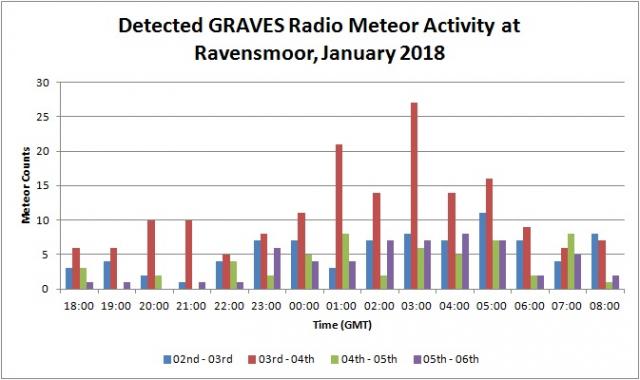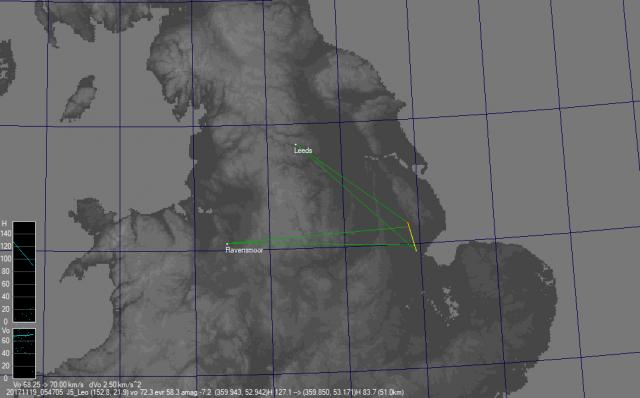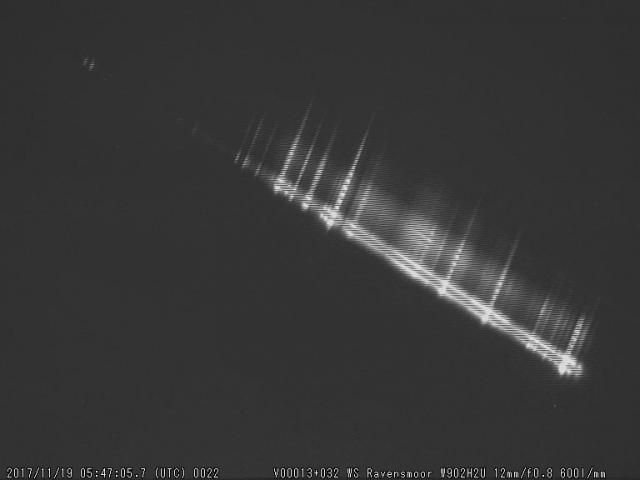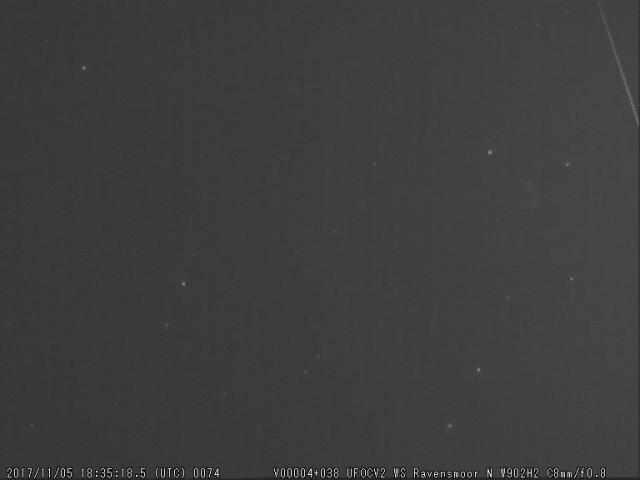Forum Replies Created
-
AuthorPosts
-
 William StewartParticipant
William StewartParticipantHi All,
This comet is predicted to occult the 12.5 magnitude star UCAC4 643-061621 on Monday 04th Dec 2023 at 22:29 GMT. Maximum predicted duration is 0.7s. The star will be low in the NW at that time (12 degrees) and the shadow path runs roughly N-S through England and Scotland.
Whether or not a dip in the brightness of the star will be detectable will of course depend on how bright the comet is at the time. This may however be a useful opportunity to gain a light profile of the coma.
My observatory is right on the edge of the predicted shadow path and I’ll need to do some trials to establish if local obstructions will prevent me making this observations – I may need to dust off the mobile system!Details of this stellar occultation are available here: https://cloud.occultwatcher.net/event/1067-12P-262541-650415-U061621
Let’s hope the weather cooperates.
Best regards
William
Attachments:
 William StewartParticipant
William StewartParticipantHi Dominic,
intereresting to see this effect plotted on a chart.
is this with or without the masking tape applied to the bezel, as suggested in the previous thread?
Best regards
William
 William StewartParticipant
William StewartParticipantHi Dominic,
Same for me too – haven’t had to refocus my cameras for years.
The lenses I use have a grub-screw on the rotating bezel which allows the focusing ring to be locked in position once focus has been achieved. In the absence of a screw you could use a small pice of masking tape to hold the focussing ring in the same position relative to the lense barrel.
As for how I achieve critical focus, I point the camera near the zenith, choosing a patch of sky that contains a combination of bright and faint stars and adjust the bezel until the faint stars become visible (when you are not in focus, the light from the faint stars is smeared out, rendering them invisible against the background sky).
Agree with Nick – spiders are a problem this time of year, as well as pollen (distinct lack of rain recently to wash the front window clean).
Best regards
William
 William StewartParticipant
William StewartParticipantCertainly an interesting development however important to consider the size of the sensor.
Based on the 7.81mm diagonal value mentioned in the article, it looks like the sensor is less than 1/4″ x 1/4″ hence is significantly smaller than the image circle of many c-mount (let alone DSLR) lenses. Hence the FOV will be correspondingly small.
 William StewartParticipant
William StewartParticipantMarco Langbroek has highlighted that the next Starlink Launch is tonight at 19:30 GMT (20:30 BST) – http://www.satobs.org/seesat/Apr-2020/0188.html
Plugging his draft elsets into Heavensat, it looks like the upper stage / satellite dispenser may be visible just below Venus at 19:50:50, rising to an altitude of 65 degrees in the south at 19:51:59 (these times are GMT and for Cheshire but should be close enough for most of the UK). The dispenser is supposed to start pushing them out around 10 minute after launch (ie out over the North Atlantic) but unclear what the separation may be by the time they rise above our horizon. Sky won’t be particularly dark so binoculars may help if the contrast is low.
Currently a little cloudy here but hopefully someone sees something.
Good Luck, William
16 September 2018 at 3:52 pm in reply to: NEMETODE Workshop, Dunsink Observatory Dublin – Sat 15th Sept #580000 William StewartParticipant
William StewartParticipantMike – as the driving force behind the meeting I just wanted to say thanks to you for all the hard work in pulling this together. The meeting was entertaining, informative and inspiring and it was good to meet up with so many friends.
Events of this quality do not happen by themselves so hats off to you for organising such a great lineup. You’ve set a very high bar for the future.
Best regards
William
 William StewartParticipant
William StewartParticipantHi Eric,
Peter Jenniskens is a well known meteor expert, often funded via NASA, and a quick search shows that he has been a co-authored a number of papers related to the spectra of re-entering satellites.
The advantage of satellites is that their trajectory / timing can be defined well in advance which allows the observer to point their camera at the right part of the sky at the right time (and have the grating correctly orientated). Alas meteors are somewhat less predictable.
One of the papers is available here: https://ntrs.nasa.gov/archive/nasa/casi.ntrs.nasa.gov/20160000307.pdf
Best regards
William
 William StewartParticipant
William StewartParticipantHi Michael,
Very nice indeed. Picked that one up on the all-sky camera from Ravensmoor in Cheshire. Single station analysis pegs it as a -4.2 Perseid. Will send the files separately for triangulation analysis.
Best regards
William

 William StewartParticipant
William StewartParticipantFurther to Nick’s comments, the UFO Capture licence is site licence and hence you do not need one for each PC. Worth having a look through the Hints & Tips section here too for suggestions on optimising the PCs.
 William StewartParticipant
William StewartParticipantHi Trevor,
Attached is the detected radio meteor activity (from GRAVES) during the Quadrantids maximum. As it turns out GRAVES was offline between 09:00 and 15:00 on the 03rd Jan but thankfully they put another few Euros in the meter in time for the forecast maximum later that night.
Obviously the geometry of the transmitter, receiver and radiant plays a part so the suggested peak in the early hours of the 04th may be misleading.
Best regards
William

 William StewartParticipant
William StewartParticipantIf you give the team at InnovAntennas a call and explain the application, they’ll tweak the antenna design to match the GRAVES frequency for no extra cost (they didn’t charge me extra). There are some additional notes here relating to a supplier of a pre-made cable too.
If you take a look at the RMOB webpage, you’ll see that everyone who was monitoring the GRAVES frequency had dropout on the night of the Geminids maximum.
 William StewartParticipant
William StewartParticipantHi All,
Yes, it looks like GRAVES was offline on the night of the Geminids maximum – there were a number of tweets about this from myself and Richard Fleet at the time – see here and here. The twitter posts include some speculation as to whether this was coincidental maintenance or was in fact a deliberate decision on the part of the GRAVES operators.
There are a number of antenna suppliers. For the GRAVES system that members of the NEMETODE team installed at Dunsink Observatory earlier in the year we used a 3 Element Yagi from InnovAntennas. Having said that, making one yourself is very straightforward and can be accomplished in an afternoon – see Paul Hyde’s instructions here.
Finally, there is lots of useful information and advice / support on detecting meteors by radio on this forum.
Hope this helps!
Best regards, William
 William StewartParticipant
William StewartParticipantHi Bill,
Does your DSLR allow you to lock the mirror in the up position?
William
 William StewartParticipant
William StewartParticipantWould help if I attached the images!


 William StewartParticipant
William StewartParticipantHi All,
Bill referenced a spectrum at the beginning of this thread that I’d captured back on 19th Nov 2017 at 05:47:05 GMT. It turns out that it was of a Leonid Fireball (absolute magnitude -7.2). Broadband problems are currently preventing me from uploading videos / addition details to the website however have attached some initial results. Thanks to the NEMETODE team as well as the multiple radio observers around the country. Fantastic to be part of such a collaborative team – meteor observing has come a long way in the past few years.
Best regards
William
 William StewartParticipant
William StewartParticipantHi Bill,
If you’re confident that Mike’s video image composite is the same event as your DSLR image then I caught it too (well, part of it). Will send pm to Mike and yourself to triangulate ground-track and confirm shower association (single-station has it as a Northern Taurid).
Best regards
William

 William StewartParticipant
William StewartParticipantObserved (recorded video) for 2 minutes either side of the predicted time from Ravensmoor, Cheshire (21km outside shadow path) – alas no occultation detected.
Best regards, William
 William StewartParticipant
William StewartParticipantHi John,
The short answer is no, it’s unlikely that the flares could be predicted however the reason for this answer deserves a more detailed explanation.
To an observer on the ground a satellite appears to flare due to the fact that a certain part of the satellite is reflecting an image of the sun down on to a particular spot on the earth. If it is a large, flat, highly reflective panel (such as the main mission antennae (MMA) on Iridium satellites) then the reflected image of the sun’s disk is well constrained into a relatively small area (typically a few 10s of km across) and the flare has the potential to be very bright. If however the reflective surface is not flat then the reflected light is scattered into a wider area and hence the flare will not be as bright.
As the earth orbits the sun and rotates on its axis, and the satellite moves in its orbit around the earth, the relative positions of the sun and satellite change and the position of the spot of reflected sunlight moves across the face of the earth. An observer on the ground therefore sees the flare if they happen to be on the track of the reflected spot of light as it moves across the face of the earth.
If we know the date, time, observer’s position on the surface of the earth and position of the satellite then we have enough information to determine if the satellite is above the observer’s local horizon (while the observer is in darkness) and the satellite is in sunlight – this is the basis for all predictions of satellite visibility.
In order to determine if a flare will occur we need to know some additional information, specifically:
1. The satellite’s shape / structure (does it have a large, relatively flat shiny panel?)
2. If such a panel exists, is the satellite’s attitude in orbit maintained in such a way that the orientation of the panel can be reliably predicted.
In the case of Iridium flares, the answers to 1 and 2 are both “Yes”. Each Iridium satellite has three MMAs (large, flat, shiny panels that are located at 120 degree intervals around the main satellite bus, tilted out at a specific angle) and the satellite’s attitude with respect to the surface of the earth and it’s orbital trajectory are maintained with a high degree of precision: the main satellite bus is orientated vertically with respect to the surface of the earth and one of the MMAs always faces into the direction of flight.
The problem we have with military satellites is that we do not know much about 1 and 2 as this information is typically classified. The fact that you’ve seen flares suggests that there is a reasonably flat shiny panel on the satellites. Is this a solar panel, an optical sensor, a communications dish or a RADAR antenna? We don’t know – and even if we did, are the positions of these predictable (and in the public domain) in advance? No, I’m afraid they are not.
Another complication is that the orbital elements of military satellites are not always very precise. For the Chinese Yaogan satellites, the US Military does helpfully make these publicly available (typically updated twice per day based RADAR returns) however they do not do the same for their own military satellites. The orbital elements for these are derived by the amateur community from visual observations and while reasonably accurate, an error of a few seconds could lead to a large uncertainty in flare visibility for a given position on the surface of the earth.
Given enough observations it may be possible to build a model that could be tested and refined. This is what actually occurred with Iridium Flares – the flares were not predicted in advance – it was by noting that flares were occasionally seen and by reviewing publicly available information (regarding the satellite’s structure and attitude maintenance) that a model was built, tested and proven to be accurate.
On a final note, the current Iridium satellite fleet is approaching the end of its operational life and they are being replaced by next generation models which do not share the same design MMAs of the current satellites. In time the older satellites will be decommissioned and their attitude will no longer by maintained. Hence the ability to accurately predict Iridium Flares will decrease. Enjoy them while you can!
Best regards
William
 William StewartParticipant
William StewartParticipantHi John,
The formation of satellites you observed on May 27th were the Yaogan 16 Triplet (Sat # 39011, 39012 & 39013) which are widely suspected as being Chinese Military Satellites – see here for some additional details.
The other formation on June 12th were the US Military NOSS 3-3 Pair (Sat #28537 & 28541) – see here for details.
Skycharts attached – an internet search will provide some additional background on what these satellites are believed to be up to.
Best regards
William
 William StewartParticipant
William StewartParticipantHi Richard – good to hear you saw it too.
For those of you who missed it there’s a video on Youtube (not taken by me I hasten to add but by “Melgigg”). Note the puff from a thruster at around 1:10
The variation in brightness of the jettisoned solar panel covers (the two fainter dots either side of the main pair) as they tumble is obvious.
Best regards
William
-
AuthorPosts

